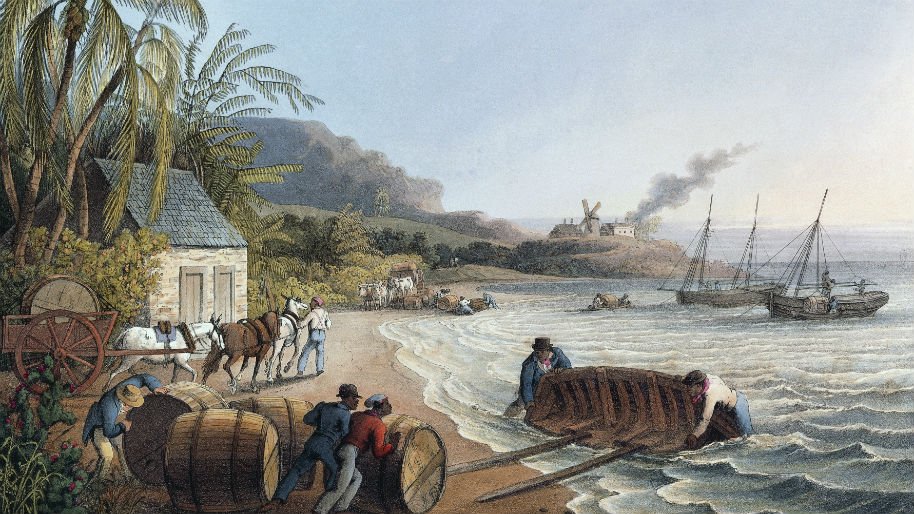Photo: Walt Disney Pictures
Rum might be the perfect spirit for summer. That’s because it’s the basis of some of the classic summery cocktails that we all know and love. From the Pina Colada, to the Dark ‘n’ Stormy, to the Daiquiri, to the Planter’s Punch, to the Mai Tai, rum seems to flow freely in warm-weather cocktails. It shouldn’t be a surprise as the spirit is most often produced Caribbean countries like Cuba, Jamaica, Barbados, and the Dominican Republic. It also shouldn’t be a surprise that today, August 16th, is National Rum Day. It’s the perfect day to read about the sugar cane-based spirit while you sip on a well-made rum-based mixed drink.

What is Rum?
In the simplest terms, rum is a distilled liquor that is made from sugarcane derivatives, including sugarcane juice, sugarcane syrup, and molasses. “Most modern rum is made from molasses through a process of fermentation and distillation, and then often barrel-aged so that the flavors and darker color of the liquid can develop,” says Gary Nelthropp, master distiller at Cruzan.
Sailor Jerry’s Legacy: The Long Love Affair Between Booze and Tattoos
How is it made?
The majority of rum is made using three ingredients – a sugar cane feedstock, yeast and water. “The variations in rum come from different types of sugar cane feedstocks, different fermentation techniques, how it is distilled, whether or not it is aged or if any flavors, colors or sugars are added back to the final product,” says Bridget Firtle, founder and head distiller at Owney’s Rum.
Sugar cane is harvested and cleaned with water. “The sugar cane is then cut and crusted to create sugar cane juice,” says Nelson Hernández, master distiller at Diplomático Rum. The cane juice gets boiled to create molasses. The next step in the process is the fermentation. This is where the molasses gets mixed together with yeast and water and left to ferment for two days. “The fermented products are then distilled through a unique process including continuous columns, a batch kettle and ancient copper pot stills,” says Hernández. “The rum is then aged in different types of casks, predominantly former bourbon and malt whisky barrels, and sherry casks.”
What is rum’s history?
The origins of rum can be dated all the way back to the 1500s when Southeast Asian merchants brought sugarcane to India. “From there, in 1590 Abu’l Fazl ibn Mubarak dedicated a whole section of the book, the Persian ‘Ain-i-Akbari’ (Constitution of Akbar), to sugar cane,” says Chris Rigby, Don Papa’s managing director of North America. In this text, it’s mentioned that sugarcane can be used to create a distilled spirit. “The book goes on to describe in detail the process of getting the sugarcane juice, fermenting it for varying periods of time, the sometimes addition of other flavors or spices and then the straining of the liquid and how it was drunk,” says Rigby.
Even though this was one of the first documented mentions of rum, researchers surmise that the real genesis of the spirit is as far back as 326 BC. “Alexander the Great’s army found reeds that supposedly ‘produced honey without there being honey bees,’” says Rigby. “They had found the sweet molasses that in later generations, many would use to make rum.”
In Case You Missed It: National Scotch Day’s Scotch Primer
Why are most rums made in the Caribbean?
There are many reasons why most rums are made in the Caribbean. “The world’s best rums are made in the Caribbean not only because of the terroir but because it provides the ideal environmental conditions needed for the production of high quality sugar cane,” says Hernández.
It actually wasn’t until 1645 that English colonists discovered rum in Barbados. “If we look at the story behind that, it’s thought that the rum may have been brought to Barbados by Dutch colonists who were fleeing the Portuguese reconquest of northern Brazil,” says Rigby. “So, although sugarcane isn’t native to the Caribbean, the growing conditions were ideal and when the area was colonized, sugarcane was introduced, and massive plantations were established.”
How does weather influence the final product?
The terroir influences the final product at every stage of the rum making process. “During production (by having an impact on the quality of the raw material and fermentation process), but also during the ageing time (weather conditions have an influence on the maturation of rum,” says Hernández.

What are the different types of rum?
There are many different types of rum within the category, as the spirit is produced in more than 80 countries and uses different kinds of fermentation, distillation, blend and aging techniques for each. “The main categories of rum are white rums, gold rums, dark rums, black strap, spiced/flavored, and overproof rum,” says Nelthropp.
On top of that, there also three distinct styles designated by three different countries. They are: French, English, and Spanish style rums. “The French style rums are also known as ‘Agricole’ and are made from fresh sugar can juice and mainly distilled with single columns,” says Hernández. “Agricole rums retain a greater amount of the sugar cane’s original flavors.”
The English style rums are often times referred to as “Navy Rum”. “British rums are made using sugar cane molasses and primarily distilled in pot stills,” says Hernández. “These rums tend to be darker with a fuller taste, leaning more toward the flavor notes of the molasses.”
The Spanish style rums are distilled using sugar cane molasses and honeys. “Typically, these are most likely distilled using columns and pot stills,” says Hernández.
What are some well-known rum cocktails?
The beauty of rum is its versatility. “There are classic shaken rum cocktails, like the daiquiri or the piña colada – both of which are my vacation staples and ones that can be made without a blender – and boozy, stirred drinks like the El Presidente made with white rum, blanc vermouth, orange curacao and grenadine,” says Firtle. “Rum is delicious, non-season specific, and a perfect addition to any home bar. Just like any tequila and vodka on your bar-cart, rum is a versatile liquor that is perfectly complementary to any mixers you may have on-hand.”





